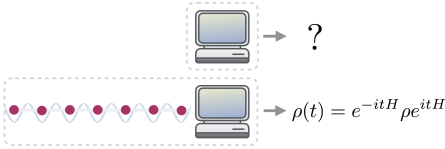Quantum Simulations
On the track to solving puzzles of complex physical properties
Every day, about one million CPU hours are spent worldwide on calculating properties of materials with the aim of identifying new materials that meet specific requirements. Powerful classical simulation methods are able to predict properties of quantum many-body systems in many relevant regimes. If strong correlations come into play, such tools necessarily reach their limits, however. Even the most powerful classical simulation methods are being seriously challenged when, for example, aiming to predict ground state properties of the Hubbard model, a model thought to play a key role in high-temperature superconductivity. It is also easy to see that with the exponentially large configuration space of quantum mechanics, even the most powerful supercomputers must reach their limits when predicting all relevant properties.

It was in 1982 when Richard Feynman had the seminal idea how to overcome this bottleneck1. In fact, so was his reasoning, a new type of physical quantum system could come to rescue when simulating strongly correlated quantum systems: These could be other quantum systems, now assembled and manipulated under precisely controlled conditions, but again following quantum laws.
These quantum simulators, as they are called today, promise to largely overcome this bottleneck, due to the highly beneficial scaling of resources. In recent years, the field of quantum simulation has been developing rapidly. This is mostly due to experimental developments, giving rise to a number of platforms in which large arrays of single quantum systems such as atoms or ions can be experimentally probed. Cold atoms in optical lattices allow the simulation of lattice models in settings in which single atoms are precisely lined up along the potential minima of standing wave laser light2. Charged ions can be kept at bay by suitable potentials in ion traps3. In these endeavors, one distinguishes three types of quantum simulators: In analog simulators, actually Hamiltonians of physical systems are rebuilt in the laboratory to study their behavior in conditions inaccessible to the original4. In digital simulators, reminiscent of quantum computing, dynamics of Hamiltonian systems is kept track of by means of quantum gates5. Quantum annealers can also be seen as instances of quantum simulators, in the way that they are special purpose devices for which quantum error correction is out of scope6.
With such quantum simulators, entirely new perspectives open up. Already with present architectures, long-standing physics puzzles can be freshly tackled: To name three examples, it has been seen how notions of temperature can emerge in complex quantum systems4. Using quantum simulators, it can be understood how disorder – a notion of randomness in quantum systems – may prevent expectations from quantum statistical mechanics to be fulfilled7. Fermionic systems are being cooled to enormously low temperatures so that it seems realistic to expect new insights into the very mechanism of high-temperature superconductivity that motivated much of the field in the first place8. Practically speaking, the most promising applications, however, could arise in contexts different from physics and materials science altogether: Realistic programmable quantum simulators9 and quantum annealers could well give rise to quantum devices that are able to solve routing and scheduling problems with polynomial speedups over classical computers10. This perspective may well turn out to be the industrially most viable application. Until this ambitious aim is reached, significant further research on manipulating precisely controlled quantum systems and on their computational power is required. The core lesson from these endeavors is that there are exciting applications waiting for us even before the large-scale fault tolerant quantum computer is built.
1 R. Feynman, Simulating physics with computers, Int. J. Theor. Phys. 21, 467 (1982).
2 I. Bloch, J. Dalibard, S. Nascimbène, Quantum simulation with ultracold atomic gases, Nature Phys. 8, 267 (2012).
3 R. Blatt and C. F. Roos, Quantum simulation with trapped ions, Nature Phys. 8, 277 (2012).
4 S. Trotzky, Y.-A. Chen, A. Flesch, I. P. McCulloch, U. Schollwock, J. Eisert, and I. Bloch,, Probing the relaxation towards equilibrium in an isolated strongly correlated 1D Bose gas, Nature Phys. 8, 325 (2012).
5 B. P. Lanyon, C. Hempel, D. Nigg, M. Müller, R. Gerritsma, F. Zähringer, P. Schindler, J. T. Barreiro, M. Rambach, G. Kirchmair, M. Hennrich, P. Zoller, R. Blatt, C. F. Roos, Universal digital quantum simulation with trapped ions, Science 334, 57 (2011).
6 T. Albash, D. A. Lidar, Adiabatic quantum computing, Rev. Mod. Phys. 90, 015002 (2018).
7 J.-Y. Choi, S. Hild, J. Zeiher, P. Schauß, A. Rubio-Abadal, T. Yefsah, V. Khemani, D. A. Huse, I. Bloch, C. Gross, Exploring the many-body localization transition in two dimensions, Science 352, 1547 (2016).
8 A. Mazurenko, C.S. Chiu, G. Ji, M.F. Parsons, M. Kanász-Nagy, R. Schmidt, F. Grusdt, E. Demler, D. Greif, M. Greiner, A cold-atom Fermi-Hubbard antiferromagnet, Nature, 545, 462 (2017).
9 H. Bernien, S. Schwartz, A. Keesling, H. Levine, A. Omran, H. Pichler, S. Choi, A. S. Zibrov, M. Endres, M. Greiner, V. Vuletić, M. D. Lukin, Probing many-body dynamics on a 51-atom quantum simulatorNature 551, 579 (2017).
10 D. von Dollen, G. Compostella, C. Seidel, S. Yarkoni, B. Parney, Traffic flow optimization using a quantum annealer, arXiv:1708.01625.



